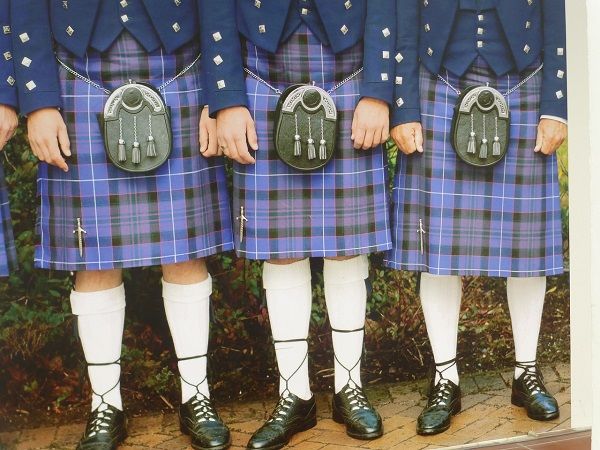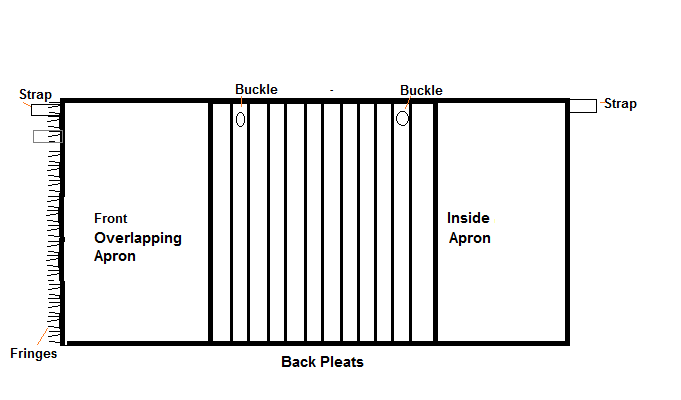The kilt is a part of the national costume of Scotland. It is a pleated knee-length wrap skirt worn mostly by men and the most recognizable symbol, when we think of Scottish highland men and their cultural heritage.

The kilt is said to have originated in Scotland as early as the 16th century. It was earlier known as belted plaid or great kilt and this referred to a tartan cloth worn around the body and belted in place. Since then it has evolved into this highly customized wrap skirt with several sharp pleats, fastened with leather straps and cast metal buckles and adorned with many many pleat styles and made in many tartan options.
In Scotland, Kilt is more than just a skirt worn by men. It represents their national pride, heritage, and cultural identity. In all the historical novels I have read so far, the kilts are always worn with pride and represented honor for the clan of the wearer (the color of the plaid fabric varied across clans – particular colors belonged solely to particular clans or regions.)
I remember reading this about kilts in the my favourite Scottish novel of all times (no, make it all time favourite novel) Outlander; I dug it out and here it is
“It had occurred to me briefly to wonder why he had worn his kilt this morning, instead of changing to breeks; the crimson tartan might be quite literally a red flag to a bull, flaunted thus before an English soldier. Now I knew.
They’d taken it from him once before, thinking to take with it pride and manhood“.
These lines say something about what kilt meant to Scottish men.

The structure of a kilt
Modern-day kilt making has taken to shortcuts as in everything but the basic structure of the kilt remains the same. The kilt consists of a middle pleated portion flanked on both sides by overlapping panels called aprons . The front apron which overlaps the other side apron closes on the right side with a strap or buckle and is often finished with fringed fabric. This apron fringe is optional.

Do you know that once upon a time the kilt was pleated on the body of the wearer and then belted in place? Now it is pre-pleated and stitched with heavy-duty double-layered lining and strapped with metal buckles and then belted in place.
The pleats in the back are usually sharp knife pleats – about 25- 30 in numbers in traditional kilts. The pleat is made of special pleating which follows the repeating pattern of the tartan referred to as a sett in kilt jargon (sett is basically the distance between adjacent squares in the plaid fabric). In the pleating of the kilt, the tartan pattern is repeated across the pleats. This gives uniformity and beauty to the pleating.
Other features of kilts are belt loops (optional) metal buckles, double layered or waistband lining, leather straps
How much Fabric is needed to sew a Kilt
Traditionally a kilt was made with about 9 yards of fabric but nowadays it is suggested that you can sew a nicely pleated kilt for about 4 -5 yards for an adult. Though with this yardage very complex pleating styles matching stripes, etc may not be possible.
You can make a knee-length kilt in about 4 meters of 54-inch fabric for an average man of hip round 45 inches ( with every 5-inch increase in hip measure add 1/2 meter to the fabric) and 2-2.5 meters is needed for making a kilt for a small child. You may want to use the same fabric as the lining in which case this calculation would be different.
What kind of fabric is used to make kilts
Kilt used to be made in only authentic Scottish wool. The weight and warmth of the wool was the most attractive characteristic of kilts. In modern kilt-making, all kinds of fabrics are used ( synthetic, cotton blends, light wools) much to the chagrin of traditional kilt admirers. Whatever material you use, remember that you need a fabric that can hold on its own, pleat like a dream, and remain pleated after it is ironed in place and worn and do not ride up the leg. A thread count of 60 count and above is desirable in kilt fabric.
Light wool in a plaid pattern is ideal. Solid-colored fabric is best for a first-time kilt maker as you do not want to bother much about the pleats matching. Wool blend plaids are less expensive.
Measurements needed for making kilts
- Hip round
- Waist round
- Waist to knee or mid-knee measurement ( the length of your kilt) For a man of 5’4 height you can make a kilt of about 22 inches long; with every 2 inch increase or decrease in length you should increase or decrease 3/4 inches from this measure.
How to sew a kilt
References for the kilt pattern
- Make an excellent pattern for a Box pleated quilt : follow the instructions here
- Wikihow: Make a Kilt
- More kilt tips
High quality traditional kilts were all handmade, handstitched. It is not so difficult to hand sew a kilt if you have the mind. But making a kilt is very easy with the sewing machine
You would have to cut the kilt pieces – the two apron pieces and the pleat fabric for the middle panel.
Attach the apron pieces to the centerpieces. Hem the bottom edge now. This hemming has to be done now as after pleating it is difficult to hem.
Now you have to pleat the centerpiece. Start pleating from under the apron. The first pleat is folded over the seam edge of the under the apron. Each pleat overlaps the other by about 3/4th. Try to pleat so that a bright stripe is centered on each pleat or at least so that the tartan pattern remains intact. The last pleat is made as a reverse pleat, pleated facing the last pleat. You will have to make sure that the lines of the checks are straight as you pleat.
Pleat and pin knife pleats so that each pleat is pinned to the pleat just on top of it. This will make all the pleats hang free. Use small sharp pins to pin the pleats. You need several of those. Now press the pleats.
Stitch each pleat vertically from the top edge to the hip line. This will make a sort of tucks which will be released from the hip line. Kiltmakers always cut off the fabric of the pleats from the back till the hipline, after the stitching is done. Otherwise, the waistline will look bulky because of all the pleats.
Make a facing for this area after the cutting is done.You can attach thick interfacing to this area for added strength.
For fastening the kilt you can opt for buckles and buttonholes or settle for the easier velcro fastening and hooks. For fastening the inner apron, velcro is used and for the outer apron you can attach hooks and eyes (the kind we use on pants). If you are using buckles and buttonholes, remember to interface the area where you will sew the buttonhole.
Bring the lining of the back piece down on the pleats and hand sew along the hipline using small hand stitches.
Bind the top edge of the kilt. If you would like to belt the kilt, you would have to add belt loops.
How to wear the kilt
Keep the pleated part behind you, bring the right side under the apron to the left side and fasten the velcro strips on the left-hand side and then fold the front overlapping apron across the front and fasten the front hooks.
Related posts : Plaid fabric ; Different varieties of clothes
Interesting reading : History of kilts – Scotland.com

This is exactly what I was looking for, thank you.
Making a kilt for my son, 6’ 1”, 234lbs. He’s spoken of wanting to lose 20 lbs.
Is it difficult adjust a kilt once made to a smaller size?